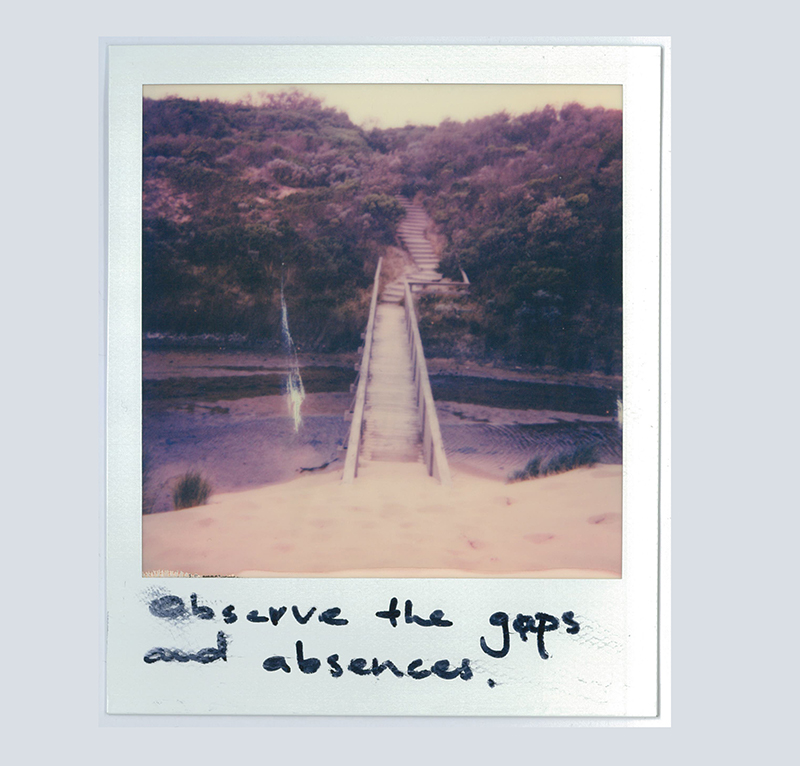Remaining attuned to multiple perspectives

Attempting to remain attuned to those with cultural perspectives tracing back tens of thousands of years, to those who have just arrived, as well as the animal and non-human inhabitants helps me grasp the rhythms of this place. A better understanding of the traditional Aboriginal names of the Bunurong Coast, its ecosystem and inhabitants, has been enlightening in this regard.
Prior to this journey, I knew the locations, animals, plants and things of this place only by their common use and colonial titles. I knew Bass Coast, Wonthaggi, Harmer’s Haven, Wreck Beach and Cape Paterson. However, the generous and diligent public dissemination of traditional language and cultural knowledge by the likes of N’wett Carolyn Briggs (Boonwurrung), Aunty Fay Stewart-Muir (Boonwurrung) and Sonia Marie (Bunurong) has shown me that these places, its animals, plants and seasonal ebbs and flows can be conceived of in many different ways.
[Audio: Acknowledgement of Country read by Rees Quilford, March 2023]
 Thanks to their work, my children and I, know about Yallock-Bulluk are the Bunurong/Boonwurrung clan that care for this section of Country.[1] We now know that Yallock is the Bunurong/Boonwurrung word for Creek or River, and that Bulluk means swamp.
Thanks to their work, my children and I, know about Yallock-Bulluk are the Bunurong/Boonwurrung clan that care for this section of Country.[1] We now know that Yallock is the Bunurong/Boonwurrung word for Creek or River, and that Bulluk means swamp.
We know Yulluk Bulluk Nayook (Black Cockatoo), we can heed the words of Bundjil (Eagle), listen to the Barroworn's (Magpie) warble, and observe Waaki (Crow) watch us. We know of Djaak (Wattle Gum), Warrak (Banksia), Muyan (Silver Wattle) and the Wurun (Manna Gum)[2]. We also understand how the seasonal rhythms of this place can be conceived of in an array of ways. We can appreciate, for example, that the Seven Wurundjeri seasons described in Woiwurrung traditions include Biderap (Dry) Season, Iuk (Eel) season, Waring (Wombat) Season, Guling (Orchid) Season, Poorneet, (Tadpole) Season, Buarth Gurru (Grass Flowering) Season and Garrawang (Kangaroo-Apple) Season[3].
This Traditional Aboriginal knowledge and language demonstrates the deep, continuing and constantly evolving histories and connections that overflow within the Bunurong Coast. Comparing and contrasting borrowings, appropriations, and the bardardisations of language also highlights its contested nature. But it also shows rich continuing histories and polyvocality.
Observing, listening and analysing helps us learn that animals, places, things, people and relationships can be known by various names and in unique ways. Each perspective and knowledge set encompass vastly different cultural, spiritual, and historical connotations. No single understanding should be prioritised over, or to the exclusion, of another. However, this research project has made it clear to me that nuanced and multifaceted understandings offer a more attuned alignment with the lived reality of this place.
Acknowledging and honouring this Traditional language and knowledge is akin to practice of re-placing narratives and suturing together segregated stories described by the Australian Historian Karen Hughes.
Adopting this approach has helped me gain different new understandings of the Bunurong Coast and I firmly believe this type of activity can only help new cross-cultural Australian histories to emerge. As Hughes argues, the act of ‘putting stories back into place’ reconnects “land, body and story, and prepares the possibility of allowing wounds to begin to heal” (Hughes, 2012, p. 274).
Works Cited
Ngarara Willim (2019) ‘Indigenous Word Cards’, RMIT University.
Marie, S. (2022) ‘Animals from Bunurong Country: Learning Language Memory Cards’
Greenway Architects’ (???) ‘The Seven Seasons of the Kulin People’ Nagara Place, RMIT University.
Gott, B. (2015) ‘The Seasonal Calendars for the Melbourne Area’
Hughes, K. ‘Mirco-histories and things that matter’ in Australian Feminist Studies, Vol.27, No.73, September 2012, p. 274
Jones, Mackay and Pisani (1997) 'The seven-season pattern for the Upper Yarra Valley' in Victorian
Naturalist.
Reid, A (1996) 'A six-season calendar for the Middle Yarra region' Victorian Naturalist
Footnotes
[1] Parks Victoria (2020) The Yallock-Bulluk Marine and Coastal Park
[2] These traditional language titles were sourced from a range of sources. This includes words articulated in the Ngarara Willim ‘Indigenous Word Card’ collection, Sonia Marie’s (2022) ‘Animals from Bunurong Country: Learning Language Memory Card’ collection, Greenway Architects’ (???) ‘The Seven Seasons of the Kulin People’ place-based installation at Nagara Place, as well as Dr. Beth Gott’s compilation of historical references entitled ‘The Seasonal Calendars for the Melbourne Area’.
[3] Jones, Mackay and Pisani proposed a seven-season pattern for the Upper Yarra Valley in 1997 (see Victorian Naturalist, 1996 & 1997). At the same time, a six-season calendar for the Middle Yarra region was proposed by Alan Reid, an interpretation that was later updated by Glen Jamerson to include the ‘late summer’ title (see Victorian Naturalist, 1996 & 1997). Detailed information about ‘The Seven Seasons of the Kulin People’ is articulated a place-based installation designed by Greenaway Architects that occupies Nagara Place at RMIT University’s city campus.